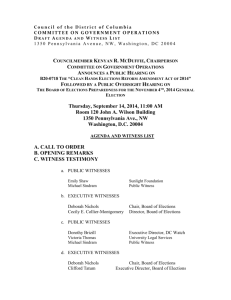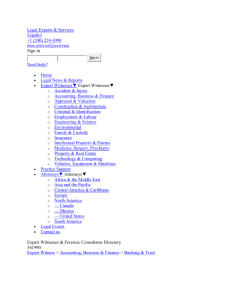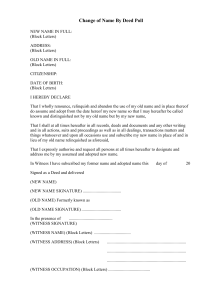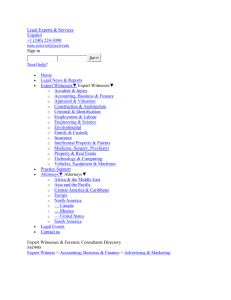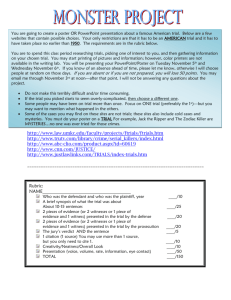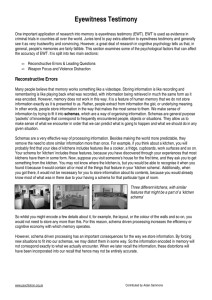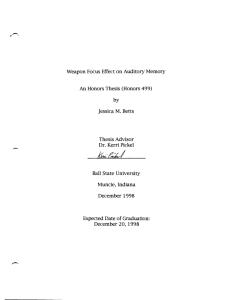Eyewitness Identification
advertisement
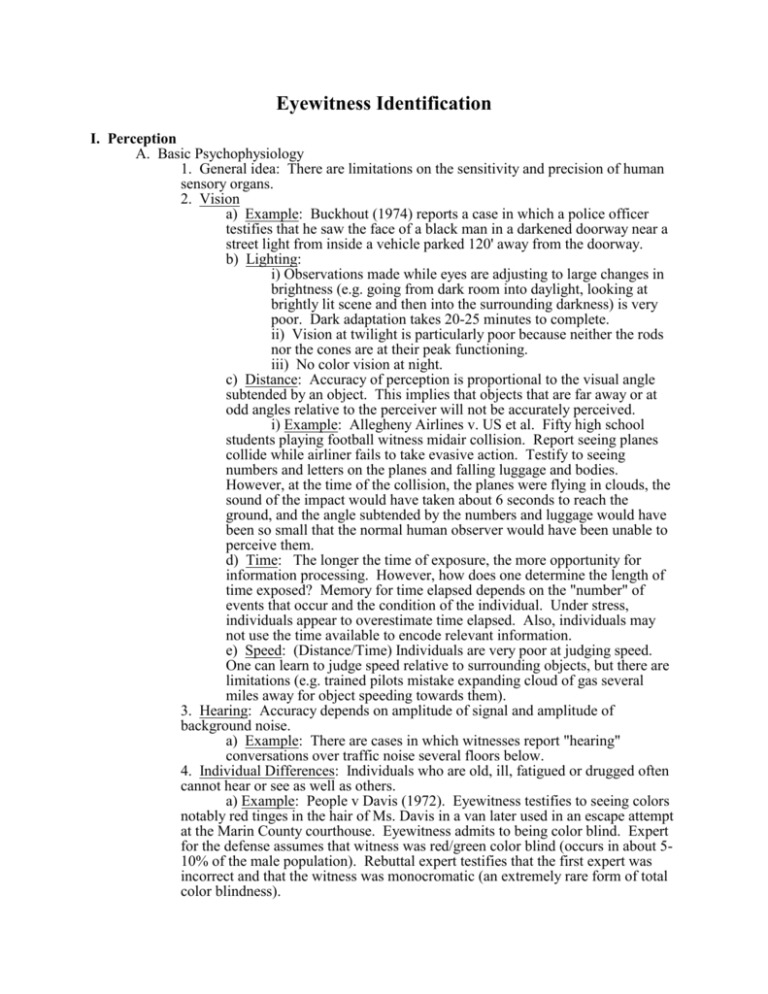
Eyewitness Identification I. Perception A. Basic Psychophysiology 1. General idea: There are limitations on the sensitivity and precision of human sensory organs. 2. Vision a) Example: Buckhout (1974) reports a case in which a police officer testifies that he saw the face of a black man in a darkened doorway near a street light from inside a vehicle parked 120' away from the doorway. b) Lighting: i) Observations made while eyes are adjusting to large changes in brightness (e.g. going from dark room into daylight, looking at brightly lit scene and then into the surrounding darkness) is very poor. Dark adaptation takes 20-25 minutes to complete. ii) Vision at twilight is particularly poor because neither the rods nor the cones are at their peak functioning. iii) No color vision at night. c) Distance: Accuracy of perception is proportional to the visual angle subtended by an object. This implies that objects that are far away or at odd angles relative to the perceiver will not be accurately perceived. i) Example: Allegheny Airlines v. US et al. Fifty high school students playing football witness midair collision. Report seeing planes collide while airliner fails to take evasive action. Testify to seeing numbers and letters on the planes and falling luggage and bodies. However, at the time of the collision, the planes were flying in clouds, the sound of the impact would have taken about 6 seconds to reach the ground, and the angle subtended by the numbers and luggage would have been so small that the normal human observer would have been unable to perceive them. d) Time: The longer the time of exposure, the more opportunity for information processing. However, how does one determine the length of time exposed? Memory for time elapsed depends on the "number" of events that occur and the condition of the individual. Under stress, individuals appear to overestimate time elapsed. Also, individuals may not use the time available to encode relevant information. e) Speed: (Distance/Time) Individuals are very poor at judging speed. One can learn to judge speed relative to surrounding objects, but there are limitations (e.g. trained pilots mistake expanding cloud of gas several miles away for object speeding towards them). 3. Hearing: Accuracy depends on amplitude of signal and amplitude of background noise. a) Example: There are cases in which witnesses report "hearing" conversations over traffic noise several floors below. 4. Individual Differences: Individuals who are old, ill, fatigued or drugged often cannot hear or see as well as others. a) Example: People v Davis (1972). Eyewitness testifies to seeing colors notably red tinges in the hair of Ms. Davis in a van later used in an escape attempt at the Marin County courthouse. Eyewitness admits to being color blind. Expert for the defense assumes that witness was red/green color blind (occurs in about 510% of the male population). Rebuttal expert testifies that the first expert was incorrect and that the witness was monocromatic (an extremely rare form of total color blindness). B. Attention 1. Problem of not looking where the action is. Why should you? Even if one is looking in the right direction, one may not attend to the legally relevant factors. Why should you? The important thing for the witnesses is usually determining where the danger is and how to avoid it -- not what color eyes the suspect had or what the license plate number was. 2. Stress & Weapons Focus Effects of stress: Under high stress individuals tend to be less accurate and tend to focus attention on source of stress. i) Johnson & Scott (1976) Subjects waiting for an experiment either 1) hear innocuous conversation about equipment failure and then see subject enter room with grease pencil, utter single line and then leave or 2) hear arguing along with crashing objects and then see subject enter room with bloodied letter opener, utter a single line and then leave. Subjects then asked to identify target person from set of 50 photographs. Results: % Correct ID Weapon Present 33 Weapon Absent 44 Note: r(confidence, accuracy)=-.21 ii) Loftus (1987) S view slide show of robbery with either a weapon present or not. Percent correct ID Weapon present 11 Weapon absent 39 iii) Clifford & Holin (1981) S view videotape of controntation which is either violent or non-violent and with either 1 or multiple perpetrators. In the single perpetrator condition: Percent correct ID Violent 30 Nonviolent 40 iv) Keuhn (1974) Survey of completeness of police reports. When victim injured, 40% of the reports are complete. When victim uninjured, 61% are complete. Implication: Stress of crime may lower accuracy of witness. Weapon may be a source of stress and focus witnesses attention on it. 3. Seriousness Leippe, Wells, & Ostrom (1978) S witness theft of object of either high (calculator) or low (cigarettes) value and find out value of object either before or after theft. Percentage of Correct Identifications Seriousness (Value) Time of Knowledge High Low Before 56.3a 18.8b b After 12.5 35.3b Implication: When crime is serious, witnesses pay more attention to theft and are better able to recognize perpetrator. Not memory effect because if find out seriousness after event there is no effect. II. Encoding A. Cultural Biases 1. Cross-Racial Identification: Differentiation increases with experience: a. Cross, Cross, & Daly (1971) 300 subjects black and white, male and female, from 4 different age groups tested for recognition of 12 photographed faces embedded in 24 new faces. % Correct Identification Black faces White faces Black subjects 39 40 White subjects 27 45 Integration not entirely effective in eliminating difference Integrated Setting Black faces White faces Black subjects 38 38 White subjects 22 34 b. Malpass & Kravitz (1969) B. Personal biases 1. Group Membership Hastorf & Cantril C. Temporary biases Segregated Setting Black faces White faces 40 41 25 48 III. Storage A. Stages of memory 1. Sensory Information Store 2. Short term memory 3. Long term memory i) Ebbinghaus curve ii) HAM model B. Episodic Memory 1. Retroactive Amnesia following trauma IV. Retrieval A. Form of questions Loftus & Zanni (1975) Item Experiment I Response Y N IDK Experiment II Response Y N IDK B. Type of questions Present Article Used “the” “a” Not Present Article Used “the” “a” 17 60 23 20 29 51 15 72 13 7 55 38 18 62 20 15 28 57 20 69 11 6 56 38 Lipton (1977) Subjects watch videotape of peaceful scene in park which is interupted by man being robbed and shot. S's asked about details in film. Accuracy Quantity Type of Questioning Narrative Interrogatory 91% 56% 21% 75% Implication: Narrative questions provide less information than interrogatory questions, but more of the information is accurate C. Faces 1. Line-ups Malpass & Devine (1981) S witness vandalism in classroom. Asked to ID offender given biased (imply offender is present) or unbiased instructions. Instructions Choice Biased Unbiased Vandal Present Vandal Other No choice 75 25 0 83 0 17 Other No choice 78 22 33 67 Vandal Absent Implication: When S's believe that suspect is present will make more errors than when instructions are unbiased. When suspect is not present and the instructions are biased, S's will nevertheless tend to pick someone. Gorenstein & Ellsworth (1980) S's watch target person interupt class. Half of the class is dismissed. Other half of the class asked to view photo line-up and pick out target person if possible (target not present). Four to six days later all S's asked to examine a second photo lineup containing the target. Proportion of S's in group making choices Group Prior Choice No Prior Choice Choice Target .22 .39 Previous Choice .44 -Implication: When S's view previous photo line-up and select photo, they are likely to choose same photograph in subsequent line-ups even if they are wrong initially and actual target person appears in the second line-up. Brown, Deffenbacher, & Sturgill (1977) D. Judging accuracy of witnesses Lindsay, Wells, & Rumpel (1981) S observe theft of calculator under conditions designed to produce Low, Medium, & Highly accurate recognition. Percent Accurate Identification Low 33 Situation Medium High 50 74 Implication: Manipulations worked. Self Reported Confidence (7 pt scale) Accurate Witnesses Inaccurate witnesses Situation Low Medium High 4.3 4.3 5.0 3.4 3.8 3.9 Implication: No effect of situation, slight effect of accuracy Percentage of Mock-jurors believing witness Witness Confidence Low High Low 47 76 Situation Medium 54 76 High 76 78 Implication: Jurors unable to take into account situational influences in determining whether witness is accurate. When the witness is confident, jurors tend to believe the witness. Wells (1979) Wells, Ferguson, & Lindsey (1981) V. Improving Eyewitness Performance A. Training 1. Tickner & Poulton (1975) 2. Woodhead et al (?) B. Hypnosis 1. Kihlstrom (1987) C. Cognitive Interview 1. Geiselman D. Other Techniques VI. Law A. U.S. v Wade (1967) Attorney must be present at lineup B. Gilbert v CA (1967) Wade protection extended to states; tainted line-up cannot be introduced at trial. C. Stovall v Denno (1967) Show-up is inherently suggestive; however, use depends on “totality of circumstances.” D. Kirby v Illinois (1972) Right to counsel at lineup only after adversary process is begun. E. Neil v Biggers (1972) Totality of circumstances elaborated. F. Manson v Brathwaite (1977) Training of witnesses recognized! VII. Repressed Memories & False Memories A. Psychology B. Law
